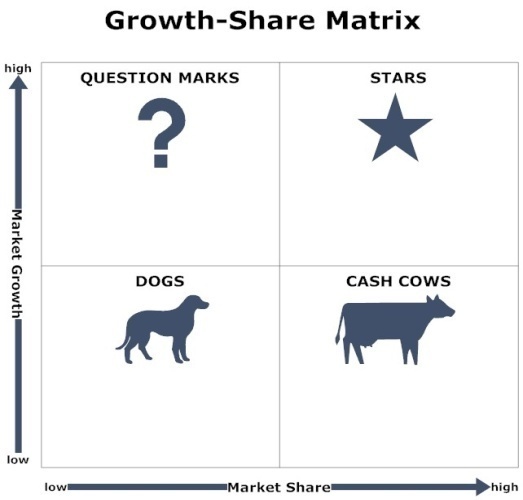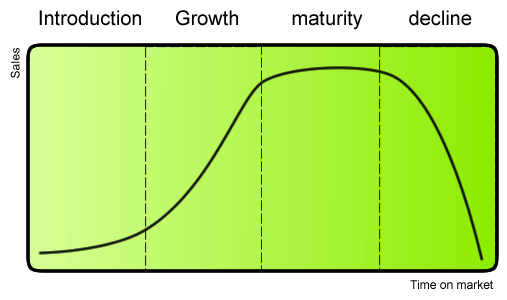
- •Unit 3 product concepts
- •Product classification
- •Vocabulary task
- •What is a product?
- •Managing the product range
- •1. Choose the Russian equivalents on the right for the following English terms on the left.
- •Product life cycle and product range
- •The growth-share matrix
- •The importance of branding
- •Branding Strategies
The growth-share matrix
The growth share matrix is a framework first developed by the Boston Consulting Group (BCG) in the 1960s to help companies think about the priority (and resources) that they should give to their different businesses. Also known as the Boston matrix, it puts each of a firm’s businesses into one of four categories. The categories were all given memorable names—Cash Cow, Star, Dog and Question Mark (Problem Child) —which helped to push them into the collective consciousness of managers all over the world.
Stars are
products with rapid growth and a dominant share of the market.
Usually, the costs of fighting off the competition and maintaining
growth mean that the product is actually absorbing more money than it
is generating, but eventually it is hoped that it will be the market
leader and the profits will begin to come back. The problem lies in
judging whether the market is going to continue to grow, or whether
it will go down as quickly as it went up. It may be difficult to
judge whether a Star is going to justify all the money that is being
poured in to maintain its growth and market share. But a firm that
does not do this will end up with just Dogs. Even the most successful
Star will eventually decline as it moves through the life cycle.
 Cash
Cows are the
former Stars. They have a dominant share of the market, but are now
in the maturity phase of the life cycle and consequently have low
growth. A Cash Cow is generating cash, and can be ‘milked’ of it
to finance the Stars. These are the products that have steady year-in
year-out sales and are generating much of the firm’s profits:
examples might be the Big Mac hamburger, Coca-Cola and the Ford
Mondeo.
Cash
Cows are the
former Stars. They have a dominant share of the market, but are now
in the maturity phase of the life cycle and consequently have low
growth. A Cash Cow is generating cash, and can be ‘milked’ of it
to finance the Stars. These are the products that have steady year-in
year-out sales and are generating much of the firm’s profits:
examples might be the Big Mac hamburger, Coca-Cola and the Ford
Mondeo.
Dogs have a low market share and low growth prospects. The argument here is not whether the product is profitable; it almost always is. The argument is about whether the firm could use its production facilities to make something that would be more profitable, and this is also almost always the case.
Question marks have a small share of a growth market, and cause the marketer the most headaches since it is necessary to work out a way of building market share so as to turn the product into a Star. This means finding out why the share is so low, and developing strategies to increase market share rapidly. The Problem Child (or Question Mark) could be backed with an even bigger promotion campaign, or it could possibly be adapted in some way to fit the market better. Market research plays a crucial role in making these decisions; finding out how to adapt a product is a difficult area of research, but the potential rewards are huge, and adapting the product to meet people’s needs better is almost always cheaper than increasing the advertising spend.
A related concept to the Growth-Share Matrix is the idea of a Strategic Business Unit (SBU). In business, SBU is a profit center which focuses on product offering and market segment. Such units typically have a discrete marketing plan, analysis of competition, and marketing campaign, even though they may be part of a larger business entity.This is the idea of treating each product area as an individual cost centre, and then being able to assess whether it is possible or not.
Concept check
Define the product life cycle.
Why can a product be compared with a living thing?
What are four stages in the product life cycle?
Describe changes in sales at each stage of the product life cycle.
Read the sentences and decide which of them are true and correct the false ones. Explain your choice.
The introduction stage of a new product requires a lot of spending.
T/F
At the introduction stage, marketers try to create customer’s brand loyalty.
T/F
At the growth stage, profits and competition grow.
T/F
The entry of competitors onto the market will make more consumers aware of the product and stimulate them to try it.
T/F
At the maturity stage, manufacturers gain profit from economies of scale.
T/F
The maturity stage is usually the longest.
T/F
Marketers start looking for more consumers once the maturity stage is reached.
T/F
When a product becomes obsolete, it enters the decline stage.
T/F
A product can have temporary increases of sales during its decline stage.
T/F
Some products may never become obsolete.
T/F
Describe the diagramme using the following phrases: At first ...; To start with ...Secondly, thirdly, etc. Then ...; Later ...; Later on ...; Afterwards ... Subsequently ...; At this point or stage ...; During this time ... Meanwhile ...; Eventually ...; In time ... Ultimately ...

Give the definition of line stretching.
What benefit does line-stretching bring to companies?
What is the growth-share matrix?
Why do companies invest in Stars?
Do the Stars necessarily give the return on the investments?
What are Cash Cows characterised by?
Why do companies continue producing Dogs?
What does the marketer try to do with of the Problem Child?
Give the definition of a Strategic Business Unit.
READING III
